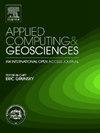Chemical map classification in XMapTools
IF 3.2
Q2 COMPUTER SCIENCE, INTERDISCIPLINARY APPLICATIONS
引用次数: 0
Abstract
Chemical mapping using electron beam or laser instruments is an important analytical technique that allows the study of the compositional variability of materials in two dimensions. While quantitative compositional mapping of minerals has received considerable attention over the last two decades, pixel misclassification in commonly used software solutions remains a fundamental limitation affecting several applications. Calibration of intensity maps to fully quantitative compositional maps requires accurate classification, for example when a calibration curve is applied to a group of pixels that are assumed to have the same matrix behavior under the electron beam or the laser. This paper compares seven automated supervised machine learning classification algorithms implemented in the open source XMapTools software along with various tools for manual classification, for selecting training data and assessing the quality of a classification result. This new implementation aims to provide the research and industry communities with a free software tool for fast and robust classification of chemical maps. A standardized color scheme with reference colors for minerals and mineral groups is proposed to improve the readability of the classified maps in petrological studies. The performance of each algorithm varies depending on the data set, especially when minerals exhibit strong compositional zoning or when different minerals have similar compositions for a given element. The random forest algorithm based on bootstrap aggregation provides satisfactory results in most situations and is recommended for general use in XMapTools.
XMapTools中的化学图分类
使用电子束或激光仪器的化学作图是一种重要的分析技术,它允许在二维空间研究材料的成分变化。虽然矿物的定量成分制图在过去二十年中受到了相当大的关注,但常用软件解决方案中的像素错误分类仍然是影响若干应用的基本限制。将强度图校准为完全定量的成分图需要精确的分类,例如,当将校准曲线应用于假定在电子束或激光下具有相同矩阵行为的一组像素时。本文比较了在开源的XMapTools软件中实现的7种自动监督机器学习分类算法,以及用于选择训练数据和评估分类结果质量的各种人工分类工具。这个新的实现旨在为研究和工业界提供一个免费的软件工具,用于快速和强大的化学图分类。为了提高岩石学研究中分类图的可读性,提出了一种具有矿物和矿物群参考色的标准化配色方案。每种算法的性能因数据集而异,特别是当矿物表现出强烈的成分分带或当不同矿物具有给定元素的相似成分时。基于自举聚合的随机森林算法在大多数情况下提供了令人满意的结果,建议在XMapTools中一般使用。
本文章由计算机程序翻译,如有差异,请以英文原文为准。
求助全文
约1分钟内获得全文
求助全文
来源期刊

Applied Computing and Geosciences
Computer Science-General Computer Science
CiteScore
5.50
自引率
0.00%
发文量
23
审稿时长
5 weeks
 求助内容:
求助内容: 应助结果提醒方式:
应助结果提醒方式:


